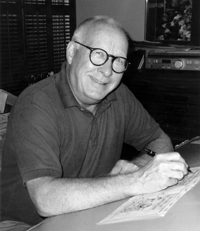Available for print / Web / mobile
Frank & Ernest stars Frank and Ernest, playful punsters with the ability to appear as any person, place or thing in any time period. The constant element is the pair's "frank and earnest" iconoclastic attitude. Frank & Ernest is read by more than 25 million people every day, making it one of today's most popular comics.

Thaves

Frank & Ernest continues to generate smiles, groans and guffaws after more than three decades of bringing a diverse audience to the comics pages. From perspectives that range from above it all to below it all, Frank & Ernest touches on a wide variety of subjects, ranging from airplanes to zoos, and the characters can be anything in any time period. The variety helps to keep this enduring comic strip fresh.
The constant element in Frank & Ernest is its frank and earnest attitude: The strip’s subject diversity is addressed with a timeless and intelligent sensibility. Wordplay often adds extra amusement to keep readers interested and involved. The result can be a twisted phrase or a skewed outlook that manages to be empathetic and ironic yet never mean-spirited. As one journalist noted, “It is a safe bet that many ‘Frank & Ernest’ enthusiasts extract more from the strip than mere amusement. Thaves’ irony-laden, pithy brand of observational humor is often inspired by the average Joe’s interaction with perplexing cultural, political, legal and theological questions.”
Frank & Ernest is one of a few strips with a readership that extends beyond a niche. Its readership cuts across demographics to include parents and children, teachers and students, managers and employees, young and old, male and female.
Frank & Ernest is read daily by an estimated 25 million readers of 1,200 newspapers. The strip enjoys a history of innovation having been the first panel presented in a strip format. It was the first to be nominated for a Reuben category award for both Syndicated Panel and Comic Strip and has won category Reuben awards three times.
Tom Thaves produces Frank & Ernest. He began to work with his father Bob, the strip’s creator, in 1997. Tom assumed more and more responsibility until he took over full-time upon Bob’s death in 2006.








 Subscribe to the News Feed
Subscribe to the News Feed